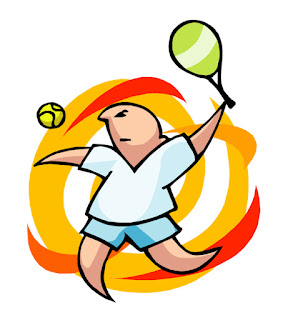Why Should Students Listen To Music During an Art Lesson?
A mother who uses ArtAchieve art lessons recently wrote to ask me,
"Why should students listen to music during an art lesson?"
What a good question! Maybe you have wondered the same thing.
To answer the question it may be helpful to make an analogy between learning a skill like tennis and learning to do art.

When I first learned to play tennis, I was constantly criticizing myself, saying things like,
-
“Oh, no!”
-
“Come on! and
-
“That was terrible!” as I swatted at the ball.
A smart friend advised me to hum while I played. “It will keep you from being so self-critical,” he said. “All that self-criticism is tripping you up.”
The simple act of humming while I played brought a big boost in my tennis skills.
Why? Because while I hummed (while I was caught up in the tune), I wasn’t able to engage in negative talk.
The negative talk had been getting in the way of my being playful, of thinking visually/spatially, and being aware of how the game was going. In addition, the negative talk had turned play into work. The result was that I was focusing on past mistakes, rather than on the present moment in the game.
The result? I just practiced the same old mistakes over and over.
Humming made me more playful; it made the game almost like a dance. As the game became more fun and playful, my skills advanced rapidly.

Playing music while doing art can work in a similar fashion, IF WE LET IT. The slight wiggle or nod of the head, or tap of the foot, can help keep us from getting tense - and tension is a sure impediment to drawing!
Music also helps us make that mind shift from verbal/analytical thought to spatial thought.
If it helps to hum along with the music you are listening to, do so. It’s another way of silencing the critic. Soothing, quiet music can also help calm the student who worries constantly about m “mistakes.”
If you prefer to SIMPLY hum like I did in tennis, (without any music playing in the background), skip playing music, and simply hum.

A skiing instructor once told us to “Ski like a gorilla.”
What he meant was to keep our joints loose, and not to tense up. I found that humming as I negotiated turns helped maintaining that looseness. One could apply the same instruction to drawing:
Last of all, however, there are a few people for whom sound of any kind can be a distraction.
For them, even the most quieting kind of music may be more of a disturbance than a help. If your child is among those who are distracted by any type of sound, silence may be better.
The important thing is to find a way to enter into the playfulness that helps us think creative thoughts and create our own unique piece of art.
A mother who uses ArtAchieve art lessons recently wrote to ask me,
"Why should students listen to music during an art lesson?"
What a good question! Maybe you have wondered the same thing.
To answer the question it may be helpful to make an analogy between learning a skill like tennis and learning to do art.

When I first learned to play tennis, I was constantly criticizing myself, saying things like,
-
“Oh, no!”
-
“Come on! and
-
“That was terrible!” as I swatted at the ball.
A smart friend advised me to hum while I played. “It will keep you from being so self-critical,” he said. “All that self-criticism is tripping you up.”
The simple act of humming while I played brought a big boost in my tennis skills.
Why? Because while I hummed (while I was caught up in the tune), I wasn’t able to engage in negative talk.
The negative talk had been getting in the way of my being playful, of thinking visually/spatially, and being aware of how the game was going. In addition, the negative talk had turned play into work. The result was that I was focusing on past mistakes, rather than on the present moment in the game.
The result? I just practiced the same old mistakes over and over.
Humming made me more playful; it made the game almost like a dance. As the game became more fun and playful, my skills advanced rapidly.

Playing music while doing art can work in a similar fashion, IF WE LET IT. The slight wiggle or nod of the head, or tap of the foot, can help keep us from getting tense - and tension is a sure impediment to drawing!
Music also helps us make that mind shift from verbal/analytical thought to spatial thought.
If it helps to hum along with the music you are listening to, do so. It’s another way of silencing the critic. Soothing, quiet music can also help calm the student who worries constantly about m “mistakes.”
If you prefer to SIMPLY hum like I did in tennis, (without any music playing in the background), skip playing music, and simply hum.

A skiing instructor once told us to “Ski like a gorilla.”
What he meant was to keep our joints loose, and not to tense up. I found that humming as I negotiated turns helped maintaining that looseness. One could apply the same instruction to drawing:
Last of all, however, there are a few people for whom sound of any kind can be a distraction.
For them, even the most quieting kind of music may be more of a disturbance than a help. If your child is among those who are distracted by any type of sound, silence may be better.
The important thing is to find a way to enter into the playfulness that helps us think creative thoughts and create our own unique piece of art.
A mother who uses ArtAchieve art lessons recently wrote to ask me,
"Why should students listen to music during an art lesson?"
What a good question! Maybe you have wondered the same thing.
To answer the question it may be helpful to make an analogy between learning a skill like tennis and learning to do art.

When I first learned to play tennis, I was constantly criticizing myself, saying things like,
-
“Oh, no!”
-
“Come on! and
-
“That was terrible!” as I swatted at the ball.
A smart friend advised me to hum while I played. “It will keep you from being so self-critical,” he said. “All that self-criticism is tripping you up.”
The simple act of humming while I played brought a big boost in my tennis skills.
Why? Because while I hummed (while I was caught up in the tune), I wasn’t able to engage in negative talk.
The negative talk had been getting in the way of my being playful, of thinking visually/spatially, and being aware of how the game was going. In addition, the negative talk had turned play into work. The result was that I was focusing on past mistakes, rather than on the present moment in the game.
The result? I just practiced the same old mistakes over and over.
Humming made me more playful; it made the game almost like a dance. As the game became more fun and playful, my skills advanced rapidly.

Playing music while doing art can work in a similar fashion, IF WE LET IT. The slight wiggle or nod of the head, or tap of the foot, can help keep us from getting tense - and tension is a sure impediment to drawing!
Music also helps us make that mind shift from verbal/analytical thought to spatial thought.
If it helps to hum along with the music you are listening to, do so. It’s another way of silencing the critic. Soothing, quiet music can also help calm the student who worries constantly about m “mistakes.”
If you prefer to SIMPLY hum like I did in tennis, (without any music playing in the background), skip playing music, and simply hum.

A skiing instructor once told us to “Ski like a gorilla.”
What he meant was to keep our joints loose, and not to tense up. I found that humming as I negotiated turns helped maintaining that looseness. One could apply the same instruction to drawing:
Last of all, however, there are a few people for whom sound of any kind can be a distraction.
For them, even the most quieting kind of music may be more of a disturbance than a help. If your child is among those who are distracted by any type of sound, silence may be better.
The important thing is to find a way to enter into the playfulness that helps us think creative thoughts and create our own unique piece of art.




